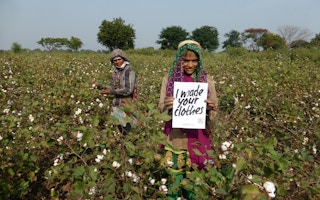They work in huts with mud floors, shacks with crumbling roofs, and if they are lucky, a semi-concrete structure that may survive this year’s monsoon floods. They are the women and girls in India who toil at the bottom of global garment supply chains, earning between $0.13 and $0.15 per hour sewing, embroidering, and adding the finishing touches to the clothes we wear every day.
For more than two decades, journalists and researchers have reported on the unsafe and low-wage working conditions in garment factories in South Asia, many of which involve varying degrees of forced labor and child labor. These “Tier 1” factories in major cities like New Delhi and Dhaka fill orders for major Western apparel brands at cut-rate prices, allowing consumers to enjoy the cheapest wardrobes possible.
Although major brands have become increasingly concerned with transparency in the formal portion of their supply chains, almost none of them have visibility into working conditions beneath these factories, down to the village level where home-based garment workers toil in heavily exploitative conditions.
Two years ago, I set out to document the conditions for the homeworkers in India’s garment industry as part of a broader mission to document the exploitative labor conditions that characterise the bottom of global supply chains—from electronics to seafood to garments and more. The results of this research were released in my report, “Tainted Garments”, through the Blum Center for Developing Economies at UC Berkeley.
Based on the cases of 1,452 home-based garment workers in and around nine cities across India, we found that more than 99 per cent of workers did not receive the anemic state-stipulated minimum wages (earning between 50 per cent and 90 per cent less than the minimum wage), more than 42 per cent began garment work as children, almost two-thirds began the work under some form of duress, and more than a third suffered severe delays in their wage payments, sometimes up to several months.
Home-based garment work is completely informal—not one worker had a written agreement for their work, not one worker belonged to a trade union, and only 0.1 per cent of workers received any sort of medical care if they suffered an injury during their work. For many of the children, garment work comes at the expense of an education, ensuring that the cycle of poverty is passed from one generation to the next.
“
More than 99 per cent of workers did not receive the anemic state-stipulated minimum wages.
“My parents could not afford to send me to school, so I do this work instead,” a 13-year old girl near the city of Sikandrabad explained.
India is the second largest exporter of apparel in the world, with 47 per cent of exports bound for the United States and European Union. Approximately 12.9 million people work in the formal portion of the industry, and millions more in the informal, home-based portion. When Tier 1 factories receive a flush of orders during periods of seasonal demand, or when they endeavor to cut production costs, they outsource to home-based workers.
Male subcontractors take materials to women and girls in villages, who typically perform work such as embroidery, tasseling, fringing, beadwork, and buttons. The subcontractors pick up the completed orders and return them to the factories, which export them to the West. The subcontractors are supposed to disburse wages, but the women and girls are always hustled out of any semblance of decent payment. They are penalised when they cannot meet excessive orders in time, or for making mistakes, or are simply unpaid for months at a time because there is not a thing they can do about it.
“We are slaves to the contractors,” a 30-year-old garment worker near New Delhi explained. “They give us less wages, but we have no alternative.”
Gender, caste, and religion play important roles in the exploitation of these women and girls. More than 99 per cent of the workers documented were either Muslim or a member of a subordinated caste group. Being a female and rural India additionally comes with a host of hostile and oppressive realities, including gender-based violence, physical and verbal abuse, and an acute lack of educational or income-generating opportunities.
“I am living in hell,” a 19-year old garment worker near the city of Bareilly explained, “I do not want to do this work.”
This young woman was sewing shirts for an apparel retailer than any consumer in the United States would recognize. I chose not to name the companies for which she and the other women and girls we documented were working because I see little merit in naming and shaming these brands.
Rather, it is my hope that they will take the time to study the results of the research and work with their suppliers in India to undertake every effort to address the harsh conditions we documented.
In many cases, Indian suppliers do not disclose their subcontracting practices to Western brands, however, brands must also be proactive at ensuring full transparency all the way down their supply chains. They must ensure that livable wages are implemented and enforced for their home-based garment workers. They should also support independent, third-party inspections of home-based work, as well as the formalisation of the sector to include contracts, unionisation, safety equipment, healthcare, and educational support for the children of the women who sew our clothes.
Those who prey on these women and girls should be aggressively prosecuted and punished. Above all, brands must begin to consider the workers at the bottom of their supply chains as employees of their companies, no matter how poor or uneducated they may be, no matter how many layers of a supply chain may separate them from headquarters, and no matter how many thousands of miles away they may live.
If brands are going to avail of cheap labor in India, they should ensure that all their workers—especially women—are treated with decency and respect. Doing so would be a powerful first step in promoting the fair and dignified treatment of all the individuals who toil in the informal underbelly of global supply chains…whose suffering, penury, and exploitation we eat, drink, and wear every day.
Siddharth Kara is a leading expert on modern slavery and child labor with positions at Harvard University and the University of California at Berkeley. This story was published with permission from Thomson Reuters Foundation, the charitable arm of Thomson Reuters, that covers humanitarian news, women’s and LGBT+ rights, human trafficking and slavery, property rights, social innovation, resilience and climate change. Visit http://news.trust.org to see more stories.









